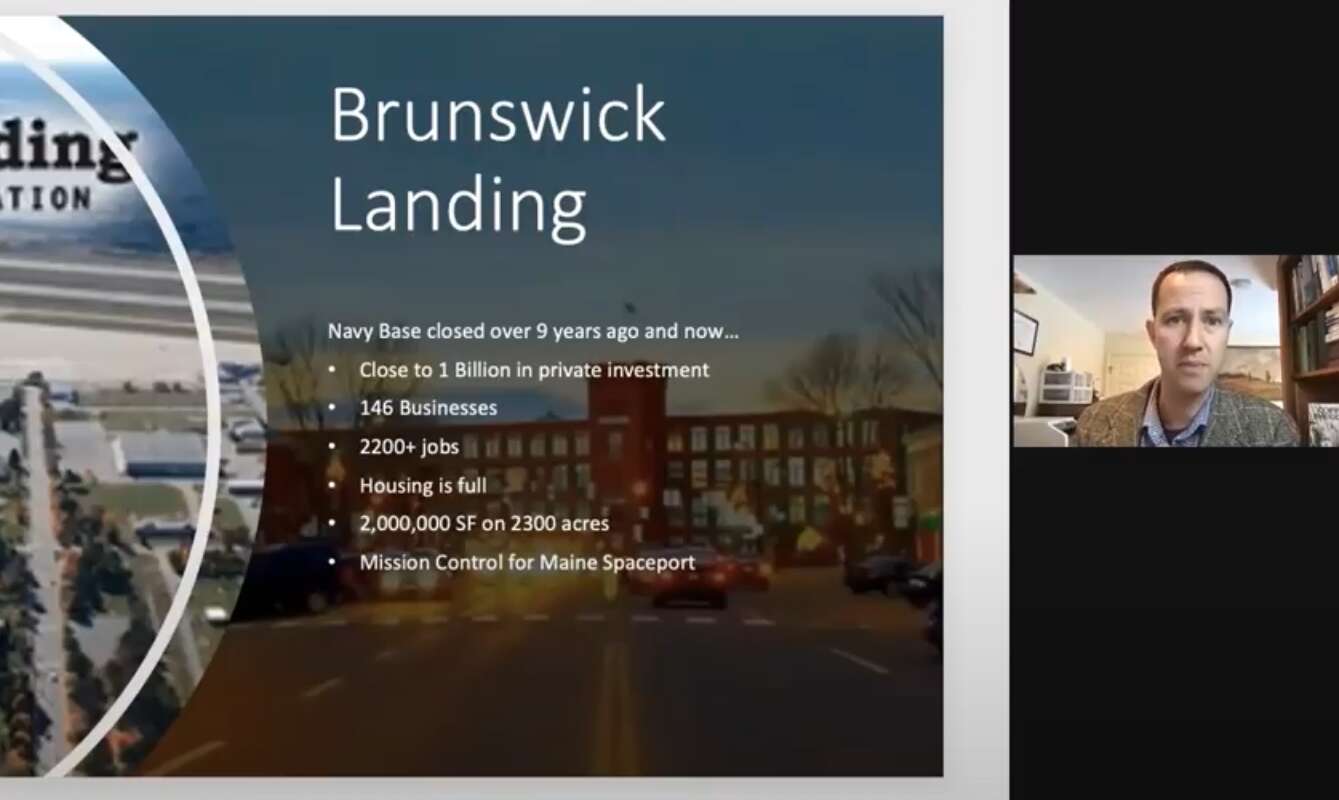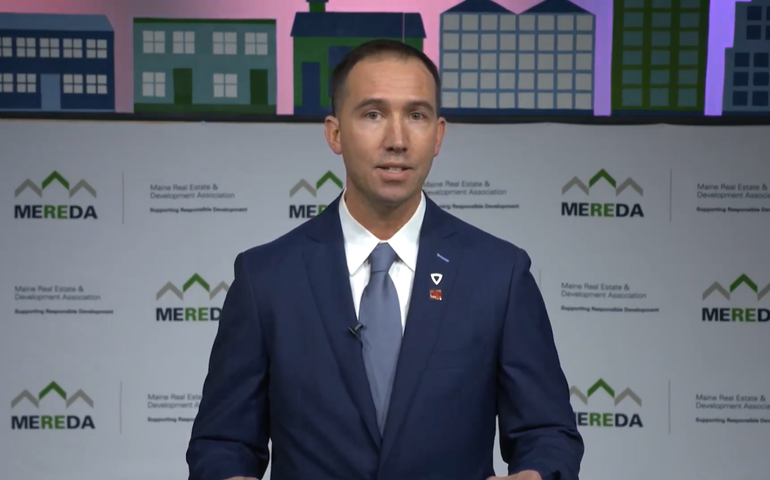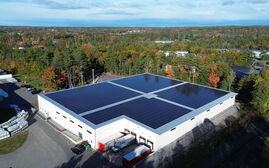
MEREDA Forecast Conference: After challenging year, mixed prospects ahead
 Image / MEREDA Forceast screen image
Justin Lamontage, of NAI The Dunham Group, discusses the southern Maine industrial forecast at the 2021 virtual MEREDA Forecast Conference.
Image / MEREDA Forceast screen image
Justin Lamontage, of NAI The Dunham Group, discusses the southern Maine industrial forecast at the 2021 virtual MEREDA Forecast Conference.
As at most events these days, there was a different look to Thursday's annual Forecast Conference of the Maine Real Estate and Development Association.
The meeting usually attracts more than 1,000 industry professionals throughout the state to Portland. This year, about 550 people registered to participate online.
And unlike last year, the buzzword of the day was "pandemic."
Mainebiz captured some of the highlights of this year's conference in the roundup below. For a closer look at the discussions of Maine's residential real estate market, click here. The conference's take on southern Maine's office and retail markets is covered here.
Mills’ innovation director outlines climate plan
In the keynote address, Hannah Pingree, director of the state Office of Innovation and the Future, outlined the challenge of climate change, which she called “the greatest threat of our age.”
Maine is already seeing rising ocean temperatures, a more severe fire season and a rise in sea levels, she said. In 2020, Portland reported recorded record-high temperatures.
The pandemic has also exposed more vulnerabilities, testing emergency preparedness and global supply chains, according to Pingree. It has strained internet connections, with more people working remotely.
Gov. Janet Mills established the Maine Climate Council to reduce greenhouse gas emissions, with such goals as reducing Maine emissions by 2030 and reaching carbon neutrality by 2045. Efforts so far have encouraged use of renewable energy, including solar, wind power. For homeowners, the administration supports weatherizing older homes and making the transition to renewable energy like heat pump
More than half of emissions in Maine come from transportation — cars, trucks and aircraft. Manufacturing counts for just 9%.
Pingree lauded the work of the Maine Climate Council, which consists of 39 scientists, industry leaders, and state and local officials. It's supported by another 230 volunteer members.
— Peter Van Allen
Maine’s economy could be slower to recover than US
James Marple, managing director and senior economist at TD Bank, said it might be 2022 before Maine’s economy recovers to pre-pandemic levels.
While Maine’s economy should see greater growth in the second half of the year, Marple said the labor market could take time to “normalize.”
The official unemployment rate reached 10.4% in Maine in April, higher than the 2008-09 recession, and was 5.0% in November. But Marple said the true unemployment rate may be closer to 7.5%, when you factor in people who have dropped out of the labor market.
He is seeing signs of job market “scarring,” meaning jobs that are lost permanently.
The pandemic, he said, has exacerbated some of the trends that were happening pre-COVID. He cited elevated government debt levels, ultra-low rates, shifts in demand for real estate, high household saving, jolt of the labor market and changing industrial policy.
While many of the economic gains seen in the summer have started to taper off, Marple cited the help the CARES Act and relief checks provided the economy.
Only Canada had a more generous support program than U.S., according to Marple.
The housing market continues to drive much of the economy, he said, citing low interest rates and increasing demand. Housing permits are expected to continue to surge this year.
“There’s a segment of the population that has done better since the pandemic and are looking to move into other housing,” he said.
— Peter Van Allen
Southern Maine industrial forecast: Strong, but pandemic questions remain
While the greater Portland industrial market navigated the COVID-19 pandemic well, and even excelled, questions remain for 2021, said Justin Lamontage, of NAI The Dunham Group.
“I feel it’s irresponsible to say that even the industrial market is immune from the impacts COVID has put on us,” he said.
Life sciences, as well as businesses deemed “essential,” that continued or ramped-up production in 2020 helped keep the market tight. Though the 2.4% vacancy rate is slightly higher than last year’s 1.8%, it’s still low, and sales and lease prices have skyrocketed.
Transaction values in southern Maine set a record in 2020. The average asking lease price in 2020 was $7.56 a square foot, triple net, and some specialty leases, like cannabis, as high as $10 to $12, said Sam LeGeyt, of NAI The Dunham Group.
Average sale prices continue to set records, LeGeyt said. The average was $75 a square foot last year, a steady climb from $40 in 2011.
“Investors are still betting heavily on the greater Portland industrial real estate market, and I don’t see that slowing down in 2021,” LeGeyt said.
Though “old obstacles” like lack of vision still slow new construction, Lamontagne said the pros are beginning to outweigh the cons, and there are more new builds and that will continue.
Lamontagne said questions for 2021 include how the trickle-down effects of the pandemic will play out, what will happen with the cannabis industry as legalization becomes more widespread, how the craft brewing industry will hold up for the next few months and what impact political turnover will have.
Predictions for 2021 are that vacancy rates and prices will stabilize; the life science sector will continue to grow; there will be expanded industrial zone land and code modifications, making it more possible; and retail and hospitality workers will discover high-end manufacturing jobs.
— Maureen Milliken
Greater Bangor’s lack of industrial space impacts growth opportunities
Historically low industrial vacancy rates in Bangor and surrounding communities is impacting business growth and community vitality, according to Bev Uhlenhake with Epstein Commercial Real Estate.
Bangor is historically an industrial hub, comprising more than half of the region’s industrial space, or about 4.1 million square feet.
Neighboring Hampden saw a modest increase in new construction in 2019 and Holden saw some new owner/user construction designed to leverage high traffic counts and low property taxes along the Route 1A corridor from Bangor to Mount Desert Island.
But the approximately 2% vacancy rate is the lowest seen in a decade, Uhlenhake said.
Bangor’s industrial inventory plummeted from 14% in 2011 to 2% in 2020. Hampden has gone from 5% in 2014 to nearly 0%.
Several factors impact the industrial sector, she said. For the last 10 years, older industrial “white elephants” have been renovated and are now back in service. Paper and tissue manufacturers have been moderately active, particularly toilet paper production over the last year, and much of the product is stored in Bangor warehouses. And construction prices continue to outpace market rents, which has kept inventory flat for many years.
Sales and lease prices have strengthened, but not enough to cover new construction costs, according to Uhlenhake. Although some companies are fulfilling their growth needs with new construction, that growth has been limited and the market as a whole isn’t yet willing or able to pay higher sales/lease prices. At the same time, she said, sales/lease prices haven’t increased enough to encourage speculative construction.
Lack of space makes it difficult for businesses to find suitable spaces for expansion and for new tenants and buyers, she noted. To satisfy demand and take advantage of growth opportunities, Greater Bangor needs more space, or businesses need to be wiling and able to pay higher rent rates, she said.
Office inventory also hasn’t grown much in the past few years, aside from the significant Bangor Savings Bank construction on Bangor’s waterfront in 2018-19.
Still, she said, there have been significant shifts and upgrades in the office market. That includes two prominent downtown office buildings bought by developers — 80 Exchange St. purchased by J.B. Brown & Sons and Sky Villa LLC’s purchase of One Merchant Plaza. Over the past year, both buildings have seen upgrades and renovations.
While the overall office inventory hasn’t increased, there have been upgrades in the quality of the inventory that gives tenants more options as they look to upgrade their spaces, Uhlenhake also noted.
Office vacancy has remained about level for the last three years. Downtown Bangor vacancy is at about 8% and suburban is about 11%. The pandemic is the big player in the office market, she noted. So far, most office tenants have retained their leases: Some are using their full spaces, others are holding onto their leases but their employees are working remotely, and some have a hybrid model.
There are competing pressures to both increase and decrease office footprints, she said. Businesses recognize that social distancing requires more space; at the same time, many have invested in technology that allows their employees to work from home. It’s unclear how the situation will pan out as far as the demand for office space goes, she said.
On the retail front, the Bangor Mall has been on a downward slide for over five years, although it’s retained three anchor tenants — JCPenney, Dick’s Sporting Goods and Furniture Mattress & More in the former Macy’s department store.
That leaves a 10,000-square-foot vacancy in the former Sears anchor location. And at least 65% of the smaller mall spaces are vacant or have temporary tenants.
Leaving out the mall building, though, demand for retail space in surrounding freestanding and strip developments has remained steady at 7% for the last three years and seem to have a vitality of their own. And secondary markets seem to be holding their own with a steady 4% vacancy rate. There’s a risk the rate could go up as retailers and restaurants try to hold on through the pandemic, she added.
The greatest challenge on the horizon is the uncertainty around how the pandemic will affect demand of space in each sector, according to Uhlenhake. “There will be winners and losers,” she said.
— Laurie Schreiber
Recognition Awards Ceremony
This year’s MEREDA award winners are:
- Robert B. Patterson Jr. Founders Award — Bill Shanahan, of Evernorth
- President’s Award — Elizabeth Frazier, of Pierce Atwood, and Tom Shoening, of Drummond & Drummond
- Public Policy Award — Kevin Sutherland, director of business development at HardyPond Construction
- Volunteer of the Year — Mark Stasium, of Camden National Bank
Legislative Agenda: Budget deficit, climate, local issues are focus
MEREDA will focus on the state budget, what impact climate change legislation has on real estate and development, historic preservation tax credits and more, Andrea C. Maker and Elizabeth Frazier said.
Maker said the leadership and makeup of the 130th Legislature hasn’t changed much, but “it helps to have seasoned leadership,” given the pandemic.
MEREDA’s advocates at the Statehouse will keep an eye on how the budget deficit, $250 million for the fiscal year ending June 30 and projected at $400 million for 2022-23, will be dealt with.
Climate change legislation, particularly efforts to modernize buildings and to build healthy and resilient communities, both with 2024 carbon-lowering goals, will affect real estate and development.
Frazier said MEREDA will continue to work with the Maine Historic Tax Credit Coalition to extend the program to 2040, as well as legislation to reduce greenhouse gas emissions and promoting weatherization in building. Proposed bills surrounding housing and housing bonds, short-term rentals, green financing, private and abandoned roads and more are also on MEREDA’s radar.
Locally, public policy advocates will continue to find ways to work with Portland’s green new deal ordinance, particularly in light of the sometimes conflicting One Climate Future effort in Portland and South Portland. Issues surrounding Portland rent control, and the possibility it will be proposed as a statewide program, will also be a continued focus.
— Maureen Milliken
Central Maine: Small commercial users, pandemic flight driving markets
Businesses in central Maine “are still paying the rent, but workers are at home,” Frank Carr, of Maine Realty Advisors, said, leading to low vacancy, yet low occupancy in commercial real estate across the Lewiston-Auburn, Augusta and Waterville markets.
In Lewiston-Auburn, the office market is relative flat, and affected by University of Southern Maine L-A College’s postponement of its move from 55 Westminster St., on the outskirts of Lewiston, to the Bates Mill downtown.
The trend is similar in Augusta, where state workers are largely working from home. Leases are mostly from smaller users, at 3,500 square feet and less.
“Driving the market is the smaller users,” he said. “The bigger entities out there are just not making decisions in the COVID freeze.”
Residential, though, is a different story, Carr said. The “flight to isolation” from denser population areas has driven up the residential market, particularly multi-family property. Waterville, for instance, had 70 multi-family transactions in 2020.
Carr expects rent increases to stay flat in L-A and Augusta, where some larger residential properties are being developed, but they’ll likely rise in Waterville as the inventory decreases.
There are some big commercial opportunities in all three areas, including the 55,000-square-foot former MaineHousing building on Water Street in downtown Augusta, new and rehabbed buildings in Auburn and Lewiston, and the FirstPark business park in Oakland, which has 12 developable lots available.
— Maureen Milliken
Midcoast Maine market forecast
If a rising tide lifts all boats, then the Bath-Brunswick area is at high tide, Dave Holman, of RE Max Riverside Commercial said in his forecast for the midcoast.
Both the residential and commercial markets have steadily grown about 9% a year in the last five years, Holman said. “It’s slow and steady growth, but we’re not a boom and bust market,” he said.

Residential growth, in particular, is driving the rest of the market. Holman pointed to the fact that 13% of the population in the Bath-Brunswick-Topsham area is non-white, compared to 7% five years ago.
“That’s important for real estate developers to be aware of,” he said. “The state’s drawing new blood, and who knows what the COVID pandemic will bring, It’s definitely a boost for Maine.”
The 2,200 jobs added at Brunswick Landing, the former naval air station, and the huge recent push for residential development on the campus is the foundation for the area’s growth, he said. “If you’re looking for why the market’s thriving, those jobs are a big part of it.”
More Brunswick Landing development, as well as Brunswick downtown renovation projects, a plan to upgrade the Topsham-Brunswick bridge, a new agricultural retail store on Route 196 in Topsham, Szanton Co.’s renovation of the former YMCA in Bath into 50 residential units, and more will keep growth steady in the area.
In 2021, the residential market, including multifamily, will remain hot. “Not just regular hot, they are red hot,” he said. “It is a very, very competitive market right now.”
Commercial will stay strong, with the exception of industries hit hard by the pandemic, like restaurants and large office. He also predicts the population will continue to grow, and inflation will emerge by the fourth quarter as the economy recovers.
— Maureen Milliken
Hotel occupancy dropped a third from 2019’s record level
Hotel occupancy in 2019 was 60.6% in 2019, a record for the Maine. Not surprisingly, occupancy dropped by a third, to 39.7%, in 2020, according to Smith Travel Research data presented by Sean Riley, president and CEO of Maine Course Hospitality Group.
Revenue for 2020 declined 42.9 % compared with 2019.
In Portland, the decline in occupancy was 35.5% and in revenue 55%.
To make it through the pandemic, the industry had to adapt, he said. That included taken more extended-stay business, such as traveling medical providers.
The industry saw the return of leisure travelers during the summer and through eh fall, he said. The return of business travelers could happen in Q2, he added.
Nationally, he said, industry experts say it could be five years before the industry returns to pre-pandemic levels. But Riley predicted the industry in Maine will get close to its 2019 numbers within the next couple of years.
— Laurie Schreiber













0 Comments